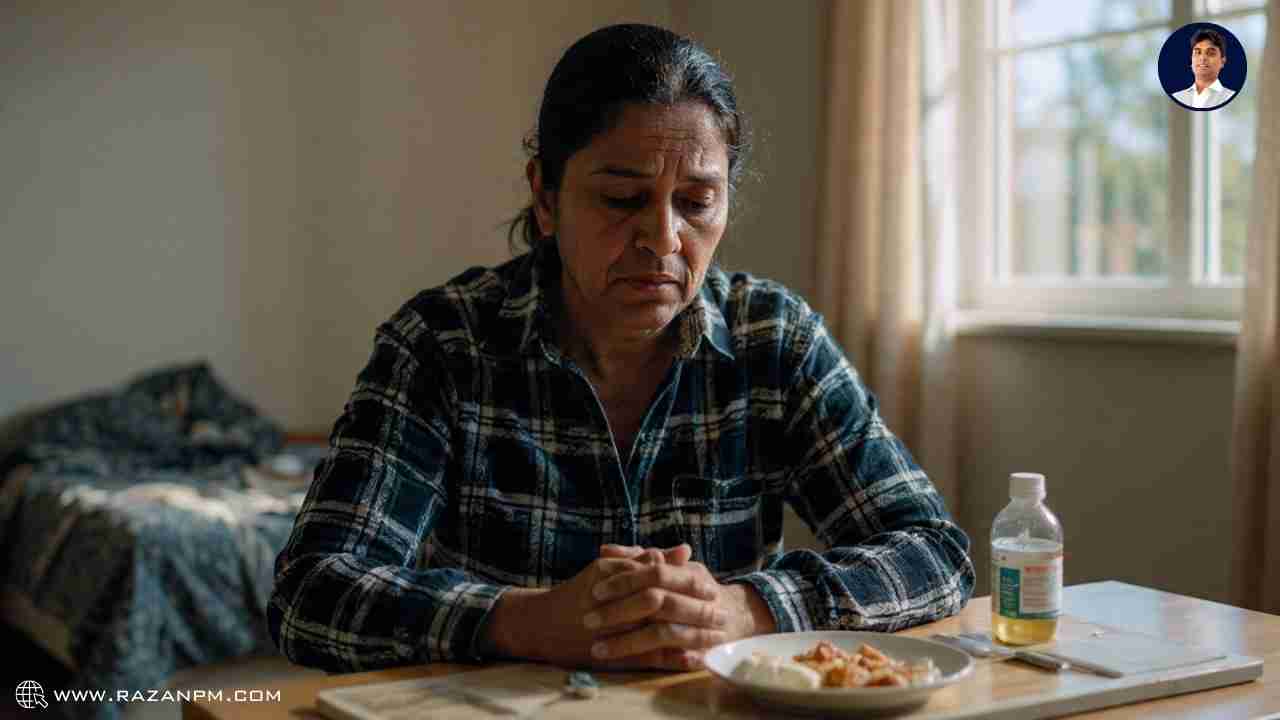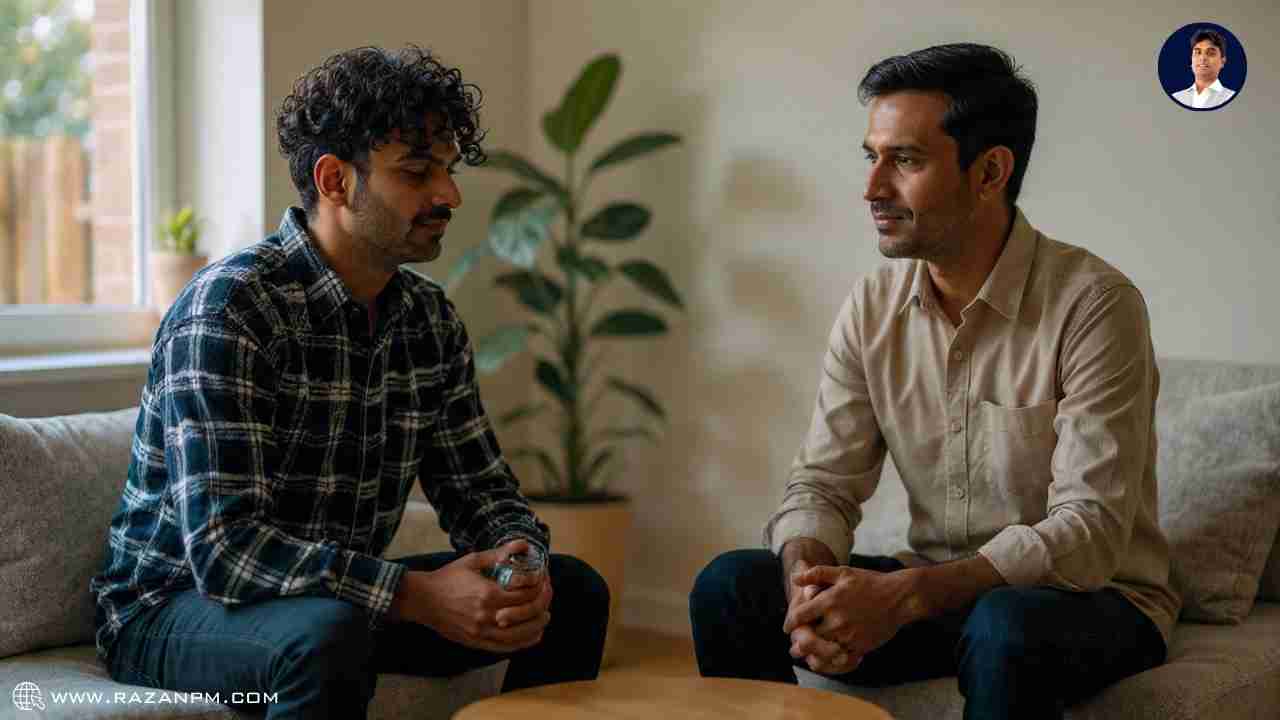Ever find yourself reaching for your phone to check a message—and suddenly your mind whispers, “What if they’re angry? What if I upset them? What if this is just the beginning of something bad?” Then you’re sitting there, in bed, the ceiling fan whirring, your muscles aching, and before you know it you’re spiralling: “I’m worthless. I can’t handle this. I’ll never feel okay again.”
If you also live with Fibromyalgia, you might know this all too well: a small pain-flare, a cancelled plan, a slight ache in your body—and suddenly the emotional wheels start turning, looping into low mood, fear of tomorrow, guilt for feeling this way. That’s when what seemed like simple chronic pain morphs into hidden depression.
also read: why saying i love you is not enough?

As a Govt.Recognized Counsellor & Mind Healer, I’ve worked with many people who say things like: “It’s not that I’m sad, I’m just done.” Or: “I’m used to hurting, but now it’s the hollowness inside that scares me more.” With fibromyalgia, you’re used to the physical pain—tender points, widespread ache, fatigue that laughs at your alarm clock. But you may not be prepared for the emotional toll. It creeps in.
You might feel:
The terror of waking up, thinking: “What will hurt today?” And the sadness of knowing it will.
This emotional maze is not just “feeling down”; it’s being locked in a cycle where pain fuels despair and despair fuels more pain.
also read: why emotional intimacy feels unsafefor some partners?

Here are some signs you may be experiencing hidden depression alongside fibromyalgia:
Heightened pain sensitivity or more frequent flare-ups when mood is low.
If you recognise many of these, you’re not imagining it—you’re likely experiencing the intersection of fibromyalgia and depression.
also read: how hormonal shifts can triggerdepression?
From the diagnostic lens: According to the Diagnostic and Statistical Manual of Mental Disorders, Fifth Edition (DSM-5), a depressive episode is characterised by at least two weeks of depressed mood or loss of interest, along with other symptoms like changes in sleep, appetite, concentration, feelings of guilt, and thoughts of death.
In the International Classification of Diseases, 11th Revision (ICD-11), depressive disorders are similarly defined by persistent sadness or loss of interest plus functional impairment.
Now here’s the kicker: With fibromyalgia, many symptoms overlap—fatigue, sleep disruption, cognitive difficulties (“fibro-fog”), aches. That makes diagnosing a depressive disorder harder. The emotional component can hide behind the physical one. Studies show that people with fibromyalgia are at much higher risk of depression.
In clinical practice, what I emphasise is: when someone with fibromyalgia starts to say “I just don’t care” or “It’s not the pain now—it’s everything,” it’s time to ask: Is this more than pain? Because when depression joins the ride, the treatment needs to include both body and mind.
also read: how chronic pain fuels depression atany age?

What this means is: your mind and body are deeply connected. The chronic pain of fibromyalgia is not just “physical”; it has emotional, cognitive, neurochemical ripples. And when depression sneaks in, it amplifies those ripples.
also read: when silence turns intomisunderstanding?
I’ll share a story (names changed for confidentiality) of “Rina”, a 34-year-old I worked with. Rina had lived with fibromyalgia for nearly five years. She told me: “Doctor, I’ve learned to live with the pain, I’ve accepted sick leave, the pills, the flare-ups. But what I cannot accept is the emptiness inside. yeh kya hai?” (“What is this?”)
One morning, she looked at herself in the mirror and after rubbing her sore neck asked, “Will I ever feel like myself again?” That question stayed with me.
We began working together: I guided her in recognising that the flare-ups and the emotional crash weren’t separate—they were intertwined. When her body screamed “pain!”, her mind responded “fear!”, then “I’m broken!”, then “why bother?”. The cycle fed itself.
We then introduced a combined approach: gentle movement (not the usual “exercise until you drop” but tailored for fibromyalgia), cognitive-emotional exploration (what are the fears behind the pain?), and mindfulness of the body-mind sensations (the ache, the worry, the terror of flare-ups). Over months, Rina reported: “It’s not that the pain vanished—but I stopped believing my body was conspiring against me.”
That moment—that shift from “my body vs me” to “body and mind working together”—is when the hidden depression began to lift. This is the solution I want to share with you.
also read: the emotional burden behind thebody’s battles

Here’s a mini-solution you can try today, in your own space:
Do this daily—or at least alternate days for a week. Track how you feel afterwards. This isn’t a fix for everything, but it acts like a tiny bridge between “just surviving pain” and “living beyond pain”.
also read: 10 coping tools for depression aftertrauma
What we touched on is just the opening door. The full journey involves deeper work: identifying your personal pain-beliefs, reframing them, building movement that honours fibromyalgia (not fights it), resolving the shame and fear that often accompany chronic pain, and rebuilding connection—with yourself, your body, your mind, and your purpose. It’s a guided process, one I lead people through in sessions, because you don’t have to do it alone.
also read: why love feels hot then cold?
If this feels familiar—if you find the ache is not just physical, but emotional too—remember: you don’t have to journey this alone. As a Govt.Recognized Counsellor & Mind Healer, I’m here to walk with you, to help your body and mind begin speaking to each other again—so you can move from surviving to living. If you’re ready to explore this deeper work, you’re welcome to [book a 1:1 consultation here].
👉 Begin Your Journey with a 1 on 1 Consultation
👉 Begin Your Journey with a 1 on 1 Consultation

Fibromyalgia and depression often occur together because chronic pain affects the brain’s neurotransmitters like serotonin and norepinephrine — the same chemicals that regulate mood. Continuous pain can drain emotional energy, leading to feelings of sadness, frustration, and hopelessness.
also read: digital romance, real loneliness genz truth
The constant fatigue, body ache, and sleep problems linked with fibromyalgia can slowly affect mental health. Many people suppress these emotions, thinking it’s “just pain,” but over time, the unexpressed sadness turns into hidden depression.
also read: 6 warning signs of depression thatincreases heart risk
Look for warning signs such as loss of motivation, increased pain sensitivity, mental fog, emotional numbness, and guilt about not “doing enough.” When your mood and pain levels rise together, it’s a key indicator of hidden depression.
also read: why small fights turn into bigarguments?
Combining medical treatment with psychological support works best. Mind-body therapy, mindfulness, light physical movement, journaling emotions, and guided counselling can reduce both pain and depressive symptoms over time.
also read: overthinking messages is killingyour peace
Fibromyalgia is a neurological pain condition, not purely mental — but it deeply affects emotional health. Chronic pain alters brain pathways that handle both pain and mood, which is why emotional healing is essential in recovery.
also read: blood sugar battles affect mentalhealth
Yes! Cognitive Behavioral Therapy (CBT), Acceptance Commitment Therapy (ACT), and mindfulness-based approaches help reframe pain thoughts, reduce stress hormones, and improve sleep. Therapy teaches your mind to stop seeing pain as the enemy.
also read: how to escape the trap of constantdigital talk?
Gentle yoga, consistent sleep schedules, stress management, balanced nutrition, and emotional expression are key. Even small actions — like gratitude journaling or guided relaxation before bed — support long-term mood and pain balance.
also read: why digital conversations arekilling real connection?
If your emotional fatigue feels heavier than your physical pain, or if you often think “I can’t handle this anymore,” it’s time to reach out. Early psychological intervention can prevent deeper depression and restore emotional resilience.
